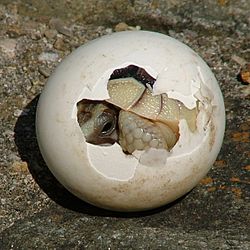Amniote facts for kids
Quick facts for kids AmniotaTemporal range: Carboniferous (Middle Mississippian) to Recent
|
|
|---|---|
 |
|
| A baby tortoise leaves its amniotic egg | |
| Scientific classification | |
| Kingdom: | |
| Phylum: | |
| Subphylum: | |
| Infraphylum: | |
| Superclass: | |
| (unranked): |
Amniota
Haeckel, 1866
|
Amniotes are a special group of animals with backbones. This group includes all reptiles, birds, and mammals. What makes them special? They lay their eggs on land or keep them inside the mother's body. This is different from fishes and amphibians, which usually lay their eggs in water.
Amniotes are tetrapods. This means they are descendants of animals with four limbs and a backbone. Their main feature is an egg that has a special protective layer called an amnion. This layer helps the egg survive on land.
Who are the Amniotes?
The amniote group includes two main branches:
- Synapsids: This group includes all mammals and their ancient relatives.
- Sauropsids: This group includes all reptiles and birds.
These groups, along with their ancestors, all share the key features of amniotes.
The Amazing Amniotic Egg
Amniote embryos, whether they are in eggs laid outside the body or carried inside the mother, are protected. They have several important membranes. For example, in mammals like humans, the baby grows inside an amniotic sac. This sac holds the fetus and keeps it safe.
These special membranes and the fact that amniotes do not have a larval stage (like tadpoles in frogs) set them apart. This is how they are different from amphibians.
How Amniotes Evolved
The first amniotes looked like small lizards. They evolved from amphibian-like animals about 312 million years ago. This happened during the Carboniferous period.
Their eggs could survive outside of water. This was a huge step! It allowed amniotes to move into drier places. The eggs could also "breathe" and handle waste better. This meant the eggs, and the animals themselves, could grow larger over time.
Related pages
See also
 In Spanish: Amniota para niños
In Spanish: Amniota para niños

